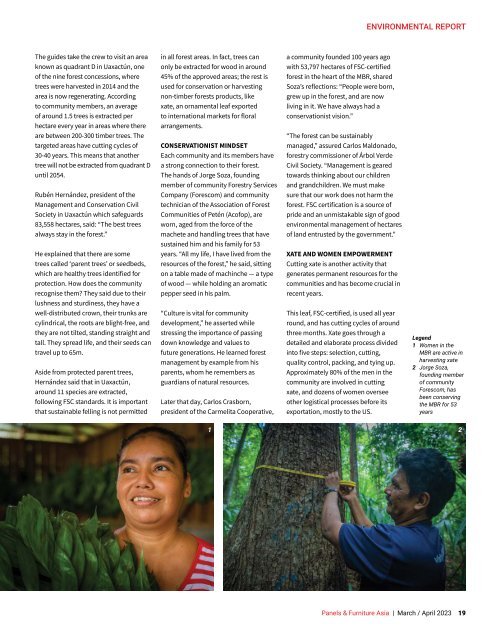Panels & Furniture Asia March/April 2023
Panels & Furniture Asia (PFA) is a leading regional trade magazine dedicated to the woodbased panel, furniture and flooring processing industry. Published bi-monthly since 2000, PFA delivers authentic journalism to cover the latest news, technology, machinery, projects, products and trade events throughout the sector. With a hardcopy and digital readership comprising manufacturers, designers and specifiers, among others, PFA is the platform of choice for connecting brands across the global woodworking landscape.
Panels & Furniture Asia (PFA) is a leading regional trade magazine dedicated to the woodbased panel, furniture and flooring processing industry. Published bi-monthly since 2000, PFA delivers authentic journalism to cover the latest news, technology, machinery, projects, products and trade events throughout the sector. With a hardcopy and digital readership comprising manufacturers, designers and specifiers, among others, PFA is the platform of choice for connecting brands across the global woodworking landscape.
Create successful ePaper yourself
Turn your PDF publications into a flip-book with our unique Google optimized e-Paper software.
ENVIRONMENTAL REPORT<br />
The guides take the crew to visit an area<br />
known as quadrant D in Uaxactún, one<br />
of the nine forest concessions, where<br />
trees were harvested in 2014 and the<br />
area is now regenerating. According<br />
to community members, an average<br />
of around 1.5 trees is extracted per<br />
hectare every year in areas where there<br />
are between 200-300 timber trees. The<br />
targeted areas have cutting cycles of<br />
30-40 years. This means that another<br />
tree will not be extracted from quadrant D<br />
until 2054.<br />
Rubén Hernández, president of the<br />
Management and Conservation Civil<br />
Society in Uaxactún which safeguards<br />
83,558 hectares, said: “The best trees<br />
always stay in the forest.”<br />
He explained that there are some<br />
trees called ‘parent trees’ or seedbeds,<br />
which are healthy trees identified for<br />
protection. How does the community<br />
recognise them? They said due to their<br />
lushness and sturdiness, they have a<br />
well-distributed crown, their trunks are<br />
cylindrical, the roots are blight-free, and<br />
they are not tilted, standing straight and<br />
tall. They spread life, and their seeds can<br />
travel up to 65m.<br />
Aside from protected parent trees,<br />
Hernández said that in Uaxactún,<br />
around 11 species are extracted,<br />
following FSC standards. It is important<br />
that sustainable felling is not permitted<br />
in all forest areas. In fact, trees can<br />
only be extracted for wood in around<br />
45% of the approved areas; the rest is<br />
used for conservation or harvesting<br />
non-timber forests products, like<br />
xate, an ornamental leaf exported<br />
to international markets for floral<br />
arrangements.<br />
CONSERVATIONIST MINDSET<br />
Each community and its members have<br />
a strong connection to their forest.<br />
The hands of Jorge Soza, founding<br />
member of community Forestry Services<br />
Company (Forescom) and community<br />
technician of the Association of Forest<br />
Communities of Petén (Acofop), are<br />
worn, aged from the force of the<br />
machete and handling trees that have<br />
sustained him and his family for 53<br />
years. “All my life, I have lived from the<br />
resources of the forest,” he said, sitting<br />
on a table made of machinche — a type<br />
of wood — while holding an aromatic<br />
pepper seed in his palm.<br />
“Culture is vital for community<br />
development,” he asserted while<br />
stressing the importance of passing<br />
down knowledge and values to<br />
future generations. He learned forest<br />
management by example from his<br />
parents, whom he remembers as<br />
guardians of natural resources.<br />
Later that day, Carlos Crasborn,<br />
president of the Carmelita Cooperative,<br />
a community founded 100 years ago<br />
with 53,797 hectares of FSC-certified<br />
forest in the heart of the MBR, shared<br />
Soza’s reflections: “People were born,<br />
grew up in the forest, and are now<br />
living in it. We have always had a<br />
conservationist vision.”<br />
“The forest can be sustainably<br />
managed,” assured Carlos Maldonado,<br />
forestry commissioner of Árbol Verde<br />
Civil Society. “Management is geared<br />
towards thinking about our children<br />
and grandchildren. We must make<br />
sure that our work does not harm the<br />
forest. FSC certification is a source of<br />
pride and an unmistakable sign of good<br />
environmental management of hectares<br />
of land entrusted by the government.”<br />
XATE AND WOMEN EMPOWERMENT<br />
Cutting xate is another activity that<br />
generates permanent resources for the<br />
communities and has become crucial in<br />
recent years.<br />
This leaf, FSC-certified, is used all year<br />
round, and has cutting cycles of around<br />
three months. Xate goes through a<br />
detailed and elaborate process divided<br />
into five steps: selection, cutting,<br />
quality control, packing, and tying up.<br />
Approximately 80% of the men in the<br />
community are involved in cutting<br />
xate, and dozens of women oversee<br />
other logistical processes before its<br />
exportation, mostly to the US.<br />
Legend<br />
1 Women in the<br />
MBR are active in<br />
harvesting xate<br />
2 Jorge Soza,<br />
founding member<br />
of community<br />
Forescom, has<br />
been conserving<br />
the MBR for 53<br />
years<br />
1 2<br />
<strong>Panels</strong> & <strong>Furniture</strong> <strong>Asia</strong> | <strong>March</strong> / <strong>April</strong> <strong>2023</strong> 19


















